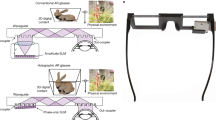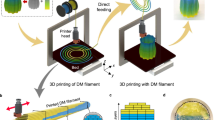Abstract
Curvy imagers that can adjust their shape are of use in imaging applications that require low optical aberration and tunable focusing power. Existing curvy imagers are either flexible but not compatible with tunable focal surfaces, or stretchable but with low resolution and pixel fill factors. Here, we show that curvy and shape-adaptive imagers with high pixel fill factors can be created by transferring an array of ultrathin silicon optoelectronic pixels with a kirigami design onto curvy surfaces using conformal additive stamp printing. An imager with a 32 × 32-pixel array exhibits a fill factor, before stretching, of 78% and can maintain its electrical performance under 30% biaxial strain. We also develop an adaptive imager that can achieve focused views of objects at different distances by combining a concave-shaped imager printed on a magnetic rubber composite with a tunable lens. Adaptive optical focus is achieved by tuning both the focal length of the lens and the curvature of the imager, allowing far and near objects to be imaged with low aberration.
This is a preview of subscription content, access via your institution
Access options
Access Nature and 54 other Nature Portfolio journals
Get Nature+, our best-value online-access subscription
$29.99 / 30 days
cancel any time
Subscribe to this journal
Receive 12 digital issues and online access to articles
$119.00 per year
only $9.92 per issue
Buy this article
- Purchase on Springer Link
- Instant access to full article PDF
Prices may be subject to local taxes which are calculated during checkout





Similar content being viewed by others
Data availability
The data that support the plots within this paper and other findings of this study are available from the corresponding author upon reasonable request.
Code availability
Custom code used to process the data is available from the corresponding author upon reasonable request.
References
Song, Y. M. et al. Digital cameras with designs inspired by the arthropod eye. Nature 497, 95–99 (2013).
Ko, H. C. et al. A hemispherical electronic eye camera based on compressible silicon optoelectronics. Nature 454, 748–753 (2008).
Kim, M. S. et al. An aquatic-vision-inspired camera based on a monocentric lens and a silicon nanorod photodiode array. Nat. Electron. 3, 546–553 (2020).
Floreano, D. et al. Miniature curved artificial compound eyes. Proc. Natl Acad. Sci. USA 110, 9267–9272 (2013).
Gu, L. et al. A biomimetic eye with a hemispherical perovskite nanowire array retina. Nature 581, 278–282 (2020).
Zhang, K. et al. Origami silicon optoelectronics for hemispherical electronic eye systems. Nat. Commun. 8, 1782 (2017).
Wu, T. et al. Design and fabrication of silicon-tessellated structures for monocentric imagers. Microsyst. Nanoeng. 2, 16019 (2016).
Guenter, B. et al. Highly curved image sensors: a practical approach for improved optical performance. Opt. Express 25, 13010–13023 (2017).
Fan, D., Lee, B., Coburn, C. & Forrest, S. R. From 2D to 3D: strain- and elongation-free topological transformations of optoelectronic circuits. Proc. Natl Acad. Sci. USA 116, 3968–3973 (2019).
Sim, K. et al. Three-dimensional curvy electronics created using conformal additive stamp printing. Nat. Electron. 2, 471–479 (2019).
Jung, I. et al. Dynamically tunable hemispherical electronic eye camera system with adjustable zoom capability. Proc. Natl Acad. Sci. USA 108, 1788–1793 (2011).
Lee, W. et al. Two-dimensional materials in functional three-dimensional architectures with applications in photodetection and imaging. Nat. Commun. 9, 1417 (2018).
Guan, Y.-S., Zhang, Z., Tang, Y., Yin, J. & Ren, S. Kirigami-inspired nanoconfined polymer conducting nanosheets with 2,000% stretchability. Adv. Mater. 30, 1706390 (2018).
Blees, M. K. et al. Graphene kirigami. Nature 524, 204–207 (2015).
Choi, G. P. T., Dudte, L. H. & Mahadevan, L. Programming shape using kirigami tessellations. Nat. Mater. 18, 999–1004 (2019).
Cho, Y. et al. Engineering the shape and structure of materials by fractal cut. Proc. Natl Acad. Sci. USA 111, 17390–17395 (2014).
Zhang, Y. et al. A mechanically driven form of kirigami as a route to 3D mesostructures in micro/nanomembranes. Proc. Natl Acad. Sci. USA 112, 11757–11764 (2015).
Wang, C., Wang, C., Huang, Z. & Xu, S. Materials and structures toward soft electronics. Adv. Mater. 30, 1801368 (2018).
Kim, D.-H. et al. Epidermal electronics. Science 333, 838 (2011).
Kim, D. H. et al. Materials and noncoplanar mesh designs for integrated circuits with linear elastic responses to extreme mechanical deformations. Proc. Natl Acad. Sci. USA 105, 18675–18680 (2008).
Shin, G. et al. Micromechanics and advanced designs for curved photodetector arrays in hemispherical electronic-eye cameras. Small 6, 851–856 (2010).
Tang, Y. et al. Design of hierarchically cut hinges for highly stretchable and reconfigurable metamaterials with enhanced strength. Adv. Mater. 27, 7181–7190 (2015).
Huang, Y. et al. Assembly and applications of 3D conformal electronics on curvilinear surfaces. Mater. Horiz. 6, 642–683 (2019).
Xu, S. et al. Assembly of micro/nanomaterials into complex, three-dimensional architectures by compressive buckling. Science 347, 154–159 (2015).
Sun, Y., Choi, W. M., Jiang, H., Huang, Y. Y. & Rogers, J. A. Controlled buckling of semiconductor nanoribbons for stretchable electronics. Nat. Nanotechnol. 1, 201–207 (2006).
Duffy, D. C., McDonald, J. C., Schueller, O. J. A. & Whitesides, G. M. Rapid prototyping of microfluidic systems in poly(dimethylsiloxane). Anal. Chem. 70, 4974–4984 (1998).
Yu, C. J. et al. Adaptive optoelectronic camouflage systems with designs inspired by cephalopod skins. Proc. Natl Acad. Sci. USA 111, 12998–13003 (2014).
Wu, Y.-L. et al. Low-power monolithically stacked organic photodiode-blocking diode imager by turn-on voltage engineering. Adv. Electron. Mater. 4, 1800311 (2018).
Lee, W. et al. High-resolution spin-on-patterning of perovskite thin films for a multiplexed image sensor array. Adv. Mater. 29, 1702902 (2017).
Kim, M. S., Lee, G. J., Kim, H. M. & Song, Y. M. Parametric optimization of lateral NIPIN phototransistors for flexible image sensors. Sensors 17, 1774 (2017).
Rim, S.-B., Catrysse, P. B., Dinyari, R., Huang, K. & Peumans, P. The optical advantages of curved focal plane arrays. Opt. Express 16, 4965–4971 (2008).
Swain, P. & Mark, D. Curved CCD detector devices and arrays for multispectral astrophysical applications and terrestrial stereo panoramic cameras. Proc. SPIE https://doi.org/10.1117/12.554840 (2004).
Jung, I., Shin, G., Malyarchuk, V., Ha, J. S. & Rogers, J. A. Paraboloid electronic eye cameras using deformable arrays of photodetectors in hexagonal mesh layouts. Appl. Phys. Lett. 96, 021110 (2010).
Lee, G. J., Nam, W. I. & Song, Y. M. Robustness of an artificially tailored fisheye imaging system with a curvilinear image surface. Opt. Laser Technol. 96, 50–57 (2017).
Dinyari, R., Rim, S.-B., Huang, K., Catrysse, P. B. & Peumans, P. Curving monolithic silicon for nonplanar focal plane array applications. Appl. Phys. Lett. 92, 091114 (2008).
Huang, C.-C. et al. Large-field-of-view wide-spectrum artificial reflecting superposition compound eyes. Small 10, 3050–3057 (2014).
Lee, G. J., Choi, C., Kim, D.-H. & Song, Y. M. Bioinspired artificial eyes: optic components, digital cameras and visual prostheses. Adv. Funct. Mater. 28, 1705202 (2018).
Sim, K. et al. Fully rubbery integrated electronics from high effective mobility intrinsically stretchable semiconductors. Sci. Adv. 5, eaav5749 (2019).
Koretz, J. F., Cook, C. A. & Kaufman, P. L. Aging of the human lens: changes in lens shape upon accommodation and with accommodative loss. J. Opt. Soc. Am. A 19, 144–151 (2002).
Lopez-Gil, N. & Fernandez-Sanchez, V. The change of spherical aberration during accommodation and its effect on the accommodation response. J. Vis. 10, 12 (2010).
Fisher, R. F. The force of contraction of the human ciliary muscle during accommodation. J. Physiol. 270, 51–74 (1977).
Li, L., Wang, Q.-H. & Jiang, W. Liquid lens with double tunable surfaces for large power tunability and improved optical performance. J. Opt. 13, 115503 (2011).
Lukman, S. et al. High oscillator strength interlayer excitons in two-dimensional heterostructures for mid-infrared photodetection. Nat. Nanotechnol. 15, 675–682 (2020).
Xie, B. et al. Self-filtering narrowband high performance organic photodetectors enabled by manipulating localized Frenkel exciton dissociation. Nat. Commun. 11, 2871 (2020).
Hollins, M. Does the central human retina stretch during accommodation? Nature 251, 729–730 (1974).
Fan, S. et al. Accommodation-induced variations in retinal thickness measured by spectral domain optical coherence tomography. J. Biomed. Opt. 19, 1–8 (2014).
Lee, H. et al. An endoscope with integrated transparent bioelectronics and theranostic nanoparticles for colon cancer treatment. Nat. Commun. 6, 10059 (2015).
Choi, C. et al. Human eye-inspired soft optoelectronic device using high-density MoS2–graphene curved image sensor array. Nat. Commun. 8, 1664 (2017).
Liu, H., Huang, Y. & Jiang, H. Artificial eye for scotopic vision with bioinspired all-optical photosensitivity enhancer. Proc. Natl Acad. Sci. USA 113, 3982–3985 (2016).
Acknowledgements
We acknowledge D. Mayerich for providing assistance with Zemax simulations, as well as the Nanofabrication Facility at the University of Houston for device fabrication. C.Y. acknowledges funding support by the National Science Foundation (ECCS-1509763 and CMMI-1554499).
Author information
Authors and Affiliations
Contributions
C.Y. and Z.R. conceived the concept and designed the work. Z.R., Y.L. and K.S. performed the experiment. Z.R., Z.L., J.X. and C.Y. performed numerical analysis. Z.R., Y.L. and C.Y. analysed the experimental data. Z.R., Y.L., Z.L., J.X. and C.Y. wrote the manuscript. All authors commented on and revised the manuscript.
Corresponding author
Ethics declarations
Competing interests
The authors declare no competing interests.
Additional information
Peer review information Nature Electronics thanks the anonymous reviewers for their contribution to the peer review of this work.
Publisher’s note Springer Nature remains neutral with regard to jurisdictional claims in published maps and institutional affiliations.
Supplementary information
Supplementary Information
Supplementary Note, Table 1, references and Figs. 1–31.
Rights and permissions
About this article
Cite this article
Rao, Z., Lu, Y., Li, Z. et al. Curvy, shape-adaptive imagers based on printed optoelectronic pixels with a kirigami design. Nat Electron 4, 513–521 (2021). https://doi.org/10.1038/s41928-021-00600-1
Received:
Accepted:
Published:
Issue Date:
DOI: https://doi.org/10.1038/s41928-021-00600-1
This article is cited by
-
Self-oscillating polymeric refrigerator with high energy efficiency
Nature (2024)
-
Liquid-metal-based three-dimensional microelectrode arrays integrated with implantable ultrathin retinal prosthesis for vision restoration
Nature Nanotechnology (2024)
-
On non-von Neumann flexible neuromorphic vision sensors
npj Flexible Electronics (2024)
-
Recent advances in bioinspired vision systems with curved imaging structures
Rare Metals (2024)
-
Handwriting of perovskite optoelectronic devices on diverse substrates
Nature Photonics (2023)



